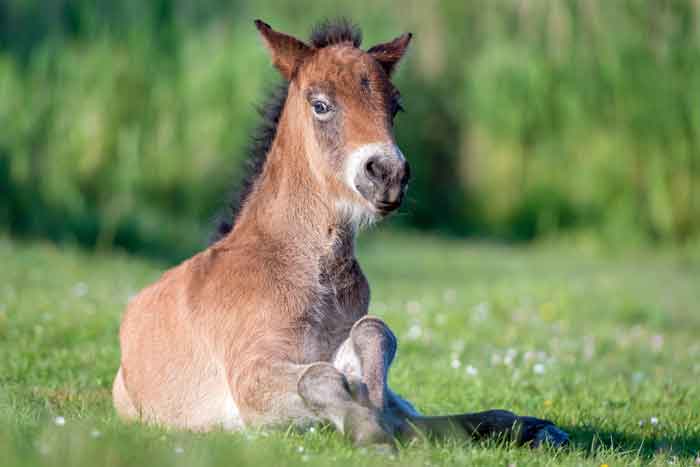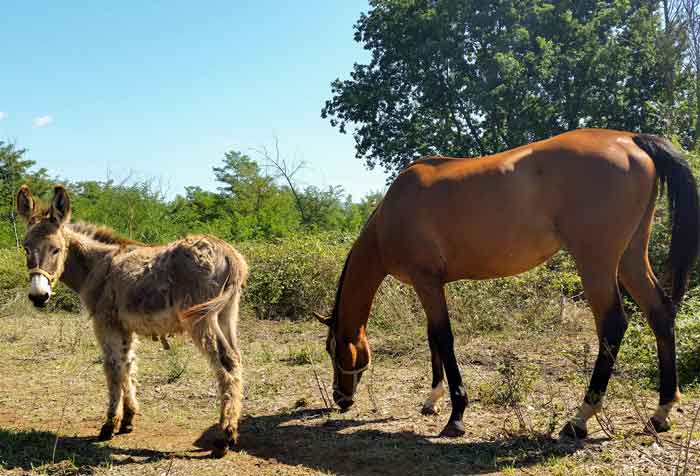Horses are very large animals that need to be well trained and treated gently.
It can be very dangerous if your animal is not able to stand still while you perform basic tasks and necessities upon them, such as grooming, saddling, mounting, training, etc.
How do you get a horse to stand still?
Teaching a horse to stand still requires a lot of one-on-one training and patience. If you are using repetitive techniques and keeping your horse comfortable and safe, you are more likely to get positive results.
Remember, horses are used to being hyper-aware, as most herd animals are. Standing still can cause them anxiety, so be gentle and patient when you train them.
Table of Contents

How Do you Get a Horse to Stand Still While Mounting?
One of the more frustrating things a horse can do when you are trying to mount them is to get distracted or walk away from you.
More dangerously, if your horse gets spooked or runs off while you are halfway on top of them, you or the horse could get hurt.
This means that training your horse to stand still while mounting is crucial to a safe and happy relationship with your large friend.
You can accidentally teach your horse bad habits if they constantly start to walk away while you try to mount them. Horses will learn that if they start to walk away, you will simply walk them back to the mounting block.
Because of this, they often will take a small lap each time before allowing you to mount them.
How Do You Fix This?
It is recommended by most horse owners that you need to remind your horse that it is more beneficial for them to stand still than to try and run off or take that extra lap.
Every time your horse doesn’t stand still the first time you try to mount them, consider putting them through a quick exercise or drill.
This will frustrate the horse and teach them that walking away from the mounting block results in more work than they want to put in at that time.
Furthermore, you need to make sure that you are never reinforcing bad habits. Always reinforce only good behavior and treat bad behavior with light exercise or groundwork.
Never get frustrated or angry with your horse, or else they will become more agitated instead and runoff.
How Do you Get a Horse to Stand Still for Saddling?
Saddling a horse can take a long time if you aren’t used to it, and is an important process if you are used to it.
Horses don’t like to sit there and wait for you to get them ready. In fact, many horses like to shift, pull away, or become agitated during the saddling and harnessing processes.
If this is your horse, you need to correct this quickly.
A horse that doesn’t like to stand around to be saddled will never be able to keep patience with their rider.
How Do You Fix This?
Sometimes an uncomfortable saddling may be coming from you and not the horse.
If you aren’t fully familiar with all the intricacies of your horse’s tack, ask for help. The more quickly and efficiently you can prepare your horse for a ride, the more comfortable they will be with you during that time.
If you are an experienced rider and your horse is still fidgeting or unhappy during the saddling process, consider what might be causing the problem.
If the horse’s tack isn’t fitting right or isn’t comfortable, get new tack.
If the horse is in a stressful environment (a loud, crowded barn, or a cramped space), they may not want to hold still long enough for you to saddle them. Move them somewhere more comfortable if this is the case.
How to Get a Horse to Stand Still When Tied Up:
Finally, if your horse simply gets bored or frustrated, remind them that this process should be a positive one.
Consider spending time with them while tied up, speaking to them, grooming them (perhaps a treat or two), and reminding them that being tied for a while with you isn’t a bad thing.
Once they are no longer irritated after standing still for a long time, saddling them and taking your time shouldn’t be such a struggle.
How Do you Get a Horse to Stand Still for Grooming?
Grooming, as well as being saddled or tied up, should be a positive experience for your horse.
This is the perfect time to bond with them, working together, and reminding your horse that you two are partners in crime.
If your horse is nervous around you or around grooming tools, try using positive reinforcement and go slow. Patience is key for an anxious horse who does not like to be tied up for a long time.
Furthermore, keeping your horse tied to a space that makes them more comfortable, rather than anxious, is very crucial, and you should only bring them back to this comfortable spot each time you need to groom them.
Check on your horse’s body language and discern what they are feeling and if they need to be moved somewhere quieter or more comfortable.
Once you have found your ideal spot to groom your horse before and after a ride, you will be able to bring them back to that spot each time.
The horse will eventually associate that spot with grooming and be less anxious or bored once they get there.
Finally, use the right grooming tools and ask for help if you’re not sure how to tackle something on your horse.
How Do you Get a Horse to Stand Still in the Horse Trailer?
Horses traditionally do not like horse trailers.
They are large animals with varying degrees of balance and a lot of weight beneath them.
This means that being in a wobbly metal box on a highway or on the road isn’t a great feeling for them, so keep that in mind when you get frustrated when they don’t stand still in the trailer.
One of the best ways to get a horse to stand still and comfortably in the trailer is by giving them some hard work beforehand.
Don’t overwork them so that they overheat, but consider tiring them out a little. Then, let them rest in a non-moving trailer so they can feel that it is a stable and comfortable space after some hard work.
This will eventually teach the horse that the trailer is a safe space.
Alternatively, you don’t want to overwork the horse and then put them into a hot metal box for a long time. This will teach them that the trailer is the LAST place they want to be.
Finally, make sure that your horse is as cool and comfortable as possible in the trailer, and make sure that you have plenty of treats or gifts for them once they’re in there.
My Horse Won’t Stand Still When Riding:
Horses recognize very small signals from you that you may not even realize you are sending to them.
This can manifest in confusion when you try to get them to stand still on the trail.
For example, if you are about to give a command, and you take on a certain sitting position, the horse will anticipate a command each time you adjust to that position.
Now, if that same sitting position is also your “let’s stop and rest” position, the horse will be confused and will be waiting for a “go” or “turn” or “faster” command.
Therefore, it is very important to have a specific body language between you and your horse when you are ready for them to stand still and rest.
How to Teach Your Horse to Stand Quietly:
Standing quietly is difficult when your horse is tied up, bored, anxious, or stuck in a trailer for a long period of time.
Horses naturally fidget if they aren’t trained to stay still, and this can be a sign of their anxious herd mentality.
A horse is an animal that likes to move and do what they like. Stubbornness in both horse and rider is a recipe for difficult training sessions.
Therefore, getting your horse to stand quietly is all about getting them used to it, comfortable, and to recognize when patience and repetition are needed.
Like we mentioned before, having a specific routine or space for your horse to wait quietly is very important to get them to do what you like.
Furthermore, positive reinforcement during long periods of standing is preferable, even out on a trail ride.
Finally, if your horse is anxious or nervous, it will be much harder for them to relax and stay still.
Keep them comfortable!
How to Calm Down Your Horse:
Calming down your horse comes down to knowing the horse and its personality.
No dog, cat, or horse is the same, and that means you need to get to know them to best help them when they are afraid or nervous.
There are a lot of ways that you can keep a horse calm, including:
- Keeping your Horse’s Attention
- Staying Calm and Quiet in the Face of Stress
- Patting and Speaking Calmly to the Horse
- Learn Your Horse’s Stressors or Triggers
- Lots of Exercises
Horses are herd animals and are used to being on the move.
In their blood, horses are instinctively going to choose flight, not fight. This means that their stress comes out in fidgeting, agitation, and taking off at a run.
If you think your horse has the potential to become stressed, you need to remain calm and keep the horse’s attention on the task at hand or on you directly.
Finally, if your horse is easily stressed or anxious, try to get them as much exercise as possible each day to try and relax them.
The more they work out their nervousness or frustration, the less likely they are to be wound up.






